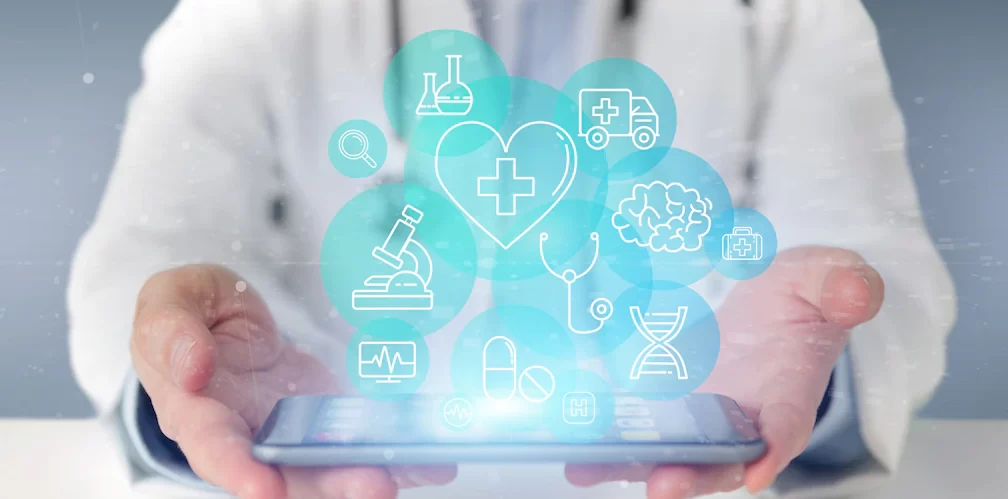4 Technological Advancements That Will Revolutionize Healthcare Forever!

Technology is a major driving force of change in the healthcare industry. The future of medical technology is unfolding right before our eyes.
Technologies like nanotech, 3D printing, artificial intelligence, informatics, and robotics are at the forefront. They are revolutionizing the industry via advanced, sophisticated workflows, procedures, and equipment.
How Can Digital Tech Transform Healthcare?
Digital tech can streamline communication between healthcare professionals and patients, optimize patient care experiences, and eradicate inefficiencies and bottlenecks in the healthcare system.
It will ultimately lead to a sustainable healthcare ecosystem with efficient and more effective illness treatment plans.
However, looking at the advancements happening all over the industry, medical professionals at all levels need to familiarize themselves with significant developments in this area.
So today, we’ll look at the best technological advances reshaping the healthcare industry.
Sophisticated Laboratory Information System
Modern labs generate a large amount of genomic data at an unprecedented rate. Considering technological advances, laboratories must update their procedures for organizing, monitoring, and centralizing data. This helps them keep up with the ever-increasing volume of genomic data and samples.
A laboratory information system (LIS) is a computerized database. This database helps laboratories keep track of their samples and the information they collect. Although an LIS is primarily used for sample management and tracking, it is capable of much more.
It can automate workflows to minimize human errors. Moreover, it centralizes quality control information for easy retrieval.
They can also integrate LIS with specialized lab instruments and systems. This helps in monitoring and data analyzing purposes and maximizing the efficiency of procedures.
Lab notes of this kind can be translated into shorter-form care notes that can then be uploaded onto various systems that medical staff or caregivers can use.
Using the right systems allows these care notes to be universally accessible by all care staff, allowing patients to get the most appropriate and up-to-date attention when required without any risk of things getting mixed up or lost.
NovoPath offers one of the best and most comprehensive laboratory information systems currently on the market.
Their award-winning LIS ensures precise and smooth operations in medical laboratories as it tracks and manages all genomic lab samples and associated data.
It facilitates seamless interoperability among all medical resources with a rapid turnaround time for all tests, including molecular and anatomic.
With a comprehensive LIS, laboratories can help medical professionals optimize the efficiency of treatment plans by leveraging genetic profiling.
In addition, LIS can help labs scale their operations as they can easily add more specialized services without worrying about capacity constraints.
Medical Document Scanners
In the healthcare industry, scanners for medical records boost process efficiency. They allow medical staff on-demand access to critical data for decision-making and routine tasks.
These document scanners represent a significant step forward in healthcare technology. This cutting-edge system will eventually make manual documentation obsolete.
Below, we have highlighted some of its core functionalities:
- You can scan medical documents anywhere you go. The scanners allow data capture and access from anywhere, whether on the go, in the office, or on the field.
In addition, users can feed new documents to the same workflows as they would when scanning in the office.
- They increase the efficiency and flexibility of scanning documents and empower remote staff members by digitizing essential documents and storing them directly in electronic health records.
Robotics
Regarding medical advancements, robotics is one of the most promising and rapidly expanding fields. Medical robots are increasingly being employed in diagnostics and operations, accelerating the digital revolution in the healthcare sector.
Robotics has allowed robots to facilitate safe interactions with infected patients. Plus, when it comes to helping people with chronic illnesses, mental health concerns, or social isolation, robots have proven to be just as helpful as traditional healthcare professionals.
Furthermore, progress has been made in everything. From surgical and disinfectant bots to exoskeleton bots, pharma bots, and robot companions, progress is very evident. Robots in surgery significantly improve success rates by lowering the chance of human error.
They can also support patients by implementing health and safety measures such as social isolation to keep people from coming in touch with each other, effectively preventing disease transmission.
They also benefit medical workers by reducing the long hours and efforts medical personnel put into their work.
Telemedicine
Telemedicine, also known as telehealth, refers to an emerging field of medicine. It is concerned with remote or digital patient assessment, diagnosis, and treatment. Telehealth relies entirely on the internet, so a device with stable internet connectivity and a telehealth app is essential for a telemedicine consultation.
The COVID-19 pandemic triggered the demand for telemedicine solutions as they can expedite the delivery of medical care.
Many leading healthcare centers have also invested in the future of this tech in hopes of
- Cutting down patient wait times,
- Minimizing patient traffic in healthcare centers and
- Reducing the transmission of disease.
As a result, this technology is being adopted by many hospitals and medical centers. Video telemedicine facilitates remote medical diagnosis and treatment by enabling qualified doctors to make online prescriptions of meds. It supports remote communication between doctors and patients.
Furthermore, it eliminates the need to wait in line at clinics and hospitals via online consultations and diagnosis. It has also provided better healthcare access to those living in rural and far-flung regions.
Cardiology Image Software
Cardiology image software is a transformative technological advancement in cardiology and medical imaging.
It enables healthcare professionals, particularly cardiologists, to analyze and interpret cardiac images more efficiently and accurately. This software can potentially revolutionize the diagnosis, treatment, and management of various cardiovascular conditions.
One of the key features of cardiology image software is its ability to process and visualize different types of cardiac images, such as:
- Echocardiograms,
- Angiograms,
- Magnetic resonance imaging (MRI), and
- Computed tomography (CT) scans.
It utilizes advanced algorithms and machine learning techniques to extract valuable information from these images, assisting cardiologists in making well-informed decisions.
With cardiology image software, healthcare providers can perform detailed measurements and quantitative analyses of the heart’s structure and function.
This includes assessing parameters like ejection fraction, chamber dimensions, myocardial perfusion, and blood flow patterns.
By automating these processes, the software reduces the risk of human error and provides more accurate and reproducible results.
Moreover, Cardiology Image Software facilitates better collaboration and communication among multidisciplinary teams involved in cardiac care.
It allows for:
- Seamless sharing and integration of images,
- Patient data and analysis results,
- Enabling cardiologists, radiologists, surgeons, and other specialists to collaborate effectively in developing comprehensive treatment plans.
Emerging Technologies Are Transforming The Healthcare Industry!
Using cutting-edge tech in healthcare can help medical professionals at all levels deliver the most optimal patient care experiences.
After all, the future is tech, and being open to new innovative technologies can help healthcare professionals stay at the top of the game for years.
Laboratory information systems, healthcare scanners, telemedicine, and robotics streamline patient care delivery and revolutionize traditional healthcare processes.
They improve patient care by facilitating the delivery of more effective and efficient treatment plans.
Read Also:

























Leave A Reply